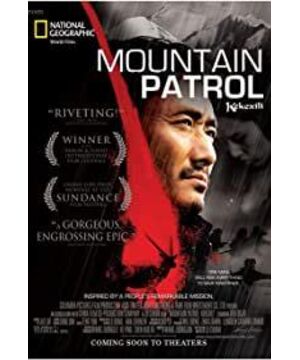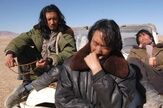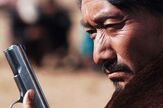Creating a sense of documentary with real audio-visual commentary on the audio-visual language of "Kekexili" Rather than saying that the film "Kekexili" directed by Lu Chuan is based on the true story of Hoh Xil, it is better to say that he used the means of film art to create a documentary-style documentary expression and reproduce the mountain tour. The real experience of the team and the hunters in the Tibetan area. With its recurring voices, long shots with strong objectivity, and clever use of colors, the film restores the hardships of the Sohu hunters of the mountain patrol team. Repeatedly intertwined sounds create an authentic atmosphere. As an indispensable part of Chinese culture, Tibetan culture is also reflected in many places in this film with Tibetans as the main characters. Among them, the prayers in Tibetan appear repeatedly in the film, which is a local folk custom and a unique way of expressing the emotions of Tibetans. Whenever someone dies in the film, devout prayers come as promised. The first time it appears is at the beginning. The old age means that Tibetans will hold celestial burials on the grass after their death. The background music at this time is the continuous sound of prayers in Tibetan. This sound drifts in the distance with the mountains and blue sky In the vast valleys of Tibetan areas, it is spread farther and farther. It seems to be regretting the passing of this highly respected senior, and it seems to be praising the merits and virtues of his life. In the vast Tibetan area of Liao Yuan, this sound is particularly powerful, making the audience haunt and unforgettable. A similar sound also appears at the end of the film. When Rita was shot dead in the snow, a prayer with strong resentment and obscure emotions sounded again. Between the ice and snow, the voice was more cohesive, trying to break through the barriers of ice and snow and move the sky. At the same time, the sudden death of a senior who was committed to protecting the natural environment of Hoh Xil, brought people's infinite sadness and regret, and was also placed in this long-standing prayer. Realistic long shots add coherent believability. In order to enhance the documentary nature of the film, the director uses a lot of long-lens shooting methods, fixed camera positions to show the changes in character behavior, and fully depicts the real life experience of the mountain patrol team and hunters. When Liu Dong encountered quicksand, he struggled hard to break free from the sand and sink, but he was helpless to sink deeper and deeper between the soft fine sand and dust. The long shot subtly recorded Liu Dong's face from the initial panic, struggling to escape until a few seconds later, when he realized that he was already unable to resist in front of the quicksand, and he showed a bit of indifference and peace. The sand under the lens forms a vortex of circulation, layer upon layer, constantly gushing out, truly portraying the powerful power of the quicksand phenomenon in Tibetan areas and Liu Dong's fearlessness in the face of life and death. In addition, the use of long shots at the end is equally remarkable. When Rita confronted the leader of the hunter, after a sudden gunshot, the audience could see Rita, who was lying in the snow, struggling to death in the long-range lens. Then, the two words of the hunter ended with the end of Rita. At the moment of the tower's life, it was as if time had frozen in the snow. A senior character who has fought against the Tibetan antelope hunting team for many years, Rita's death gives the audience more unexpected possibilities. The long-lens shooting method also gives the audience time to release their emotions. The unique use of colors reproduces the real regional style of Qinghai. The overall color of the film is mainly gray and cool, and the images of snowy mountains, snow, and wilderness also make the overall color of the picture mainly gray, white, and yellow, and a sense of wildness emerges spontaneously. The undulating high mountain vistas and the vast and far snowy landscapes that appear many times create a strong and bleak color for the picture, which truly restores the local characteristic landscape. It is worth mentioning that red also appears in the film as a color that is the exact opposite of the overall tone of the film. The blood between the bones and flesh of the Tibetan antelope is the most typical red representative of the film. It symbolizes blood and slaughter, a critique of the cruel and evil deeds of ruthless hunters, and a strong warning against evil forces. The strong impact of colors here also makes it easier for the audience to accept the local ecological environment, and its regional characteristics are self-evident. And when the mountain patrol team sits together to eat and hunt rabbits, the bloodshot legs are much more gentle in the emotional expression of color. This seems to be a cheering ceremony for the members of the mountain patrol team before the expedition again. It is a manifestation of the brave spirit of the team members who are not afraid of pain. From this, it can also be seen that the water and fire between the mountain patrol team members and the hunters are incompatible, and the regional conflicts are vividly displayed. . The unique use of colors reproduces the real regional style of Qinghai. The overall color of the film is mainly gray and cool, and the images of snowy mountains, snow, and wilderness also make the overall color of the picture mainly gray, white, and yellow, and a sense of wildness emerges spontaneously. The undulating high mountain vistas and the vast and far snowy landscapes that appear many times create a strong and bleak color for the picture, which truly restores the local characteristic landscape. It is worth mentioning that red also appears in the film as a color that is the exact opposite of the overall tone of the film. The blood between the bones and flesh of the Tibetan antelope is the most typical red representative of the film. It symbolizes blood and slaughter, a critique of the cruel and evil deeds of ruthless hunters, and a strong warning against evil forces. The strong impact of colors here also makes it easier for the audience to accept the local ecological environment, and its regional characteristics are self-evident. And when the mountain patrol team sits together to eat and hunt rabbits, the bloodshot legs are much more gentle in the emotional expression of color. This seems to be a cheering ceremony for the members of the mountain patrol team before the expedition again. It is a manifestation of the brave spirit of the team members who are not afraid of pain. From this, it can also be seen that the water and fire between the mountain patrol team members and the hunters are incompatible, and the regional conflicts are vividly displayed. . The unique use of colors reproduces the real regional style of Qinghai. The overall color of the film is mainly gray and cool, and the images of snowy mountains, snow, and wilderness also make the overall color of the picture mainly gray, white, and yellow, and a sense of wildness emerges spontaneously. The undulating high mountain vistas and the vast and far snowy landscapes that appear many times create a strong and bleak color for the picture, which truly restores the local characteristic landscape. It is worth mentioning that red also appears in the film as a color that is the exact opposite of the overall tone of the film. The blood between the bones and flesh of the Tibetan antelope is the most typical red representative of the film. It symbolizes blood and slaughter, a critique of the cruel and evil deeds of ruthless hunters, and a strong warning against evil forces. The strong impact of colors here also makes it easier for the audience to accept the local ecological environment, and its regional characteristics are self-evident. And when the mountain patrol team sits together to eat and hunt rabbits, the bloodshot legs are much more gentle in the emotional expression of color. This seems to be a cheering ceremony for the members of the mountain patrol team before the expedition again. It is a manifestation of the brave spirit of the team members who are not afraid of pain. From this, it can also be seen that the water and fire between the mountain patrol team members and the hunters are incompatible, and the regional conflicts are vividly displayed. .
View more about Mountain Patrol reviews










